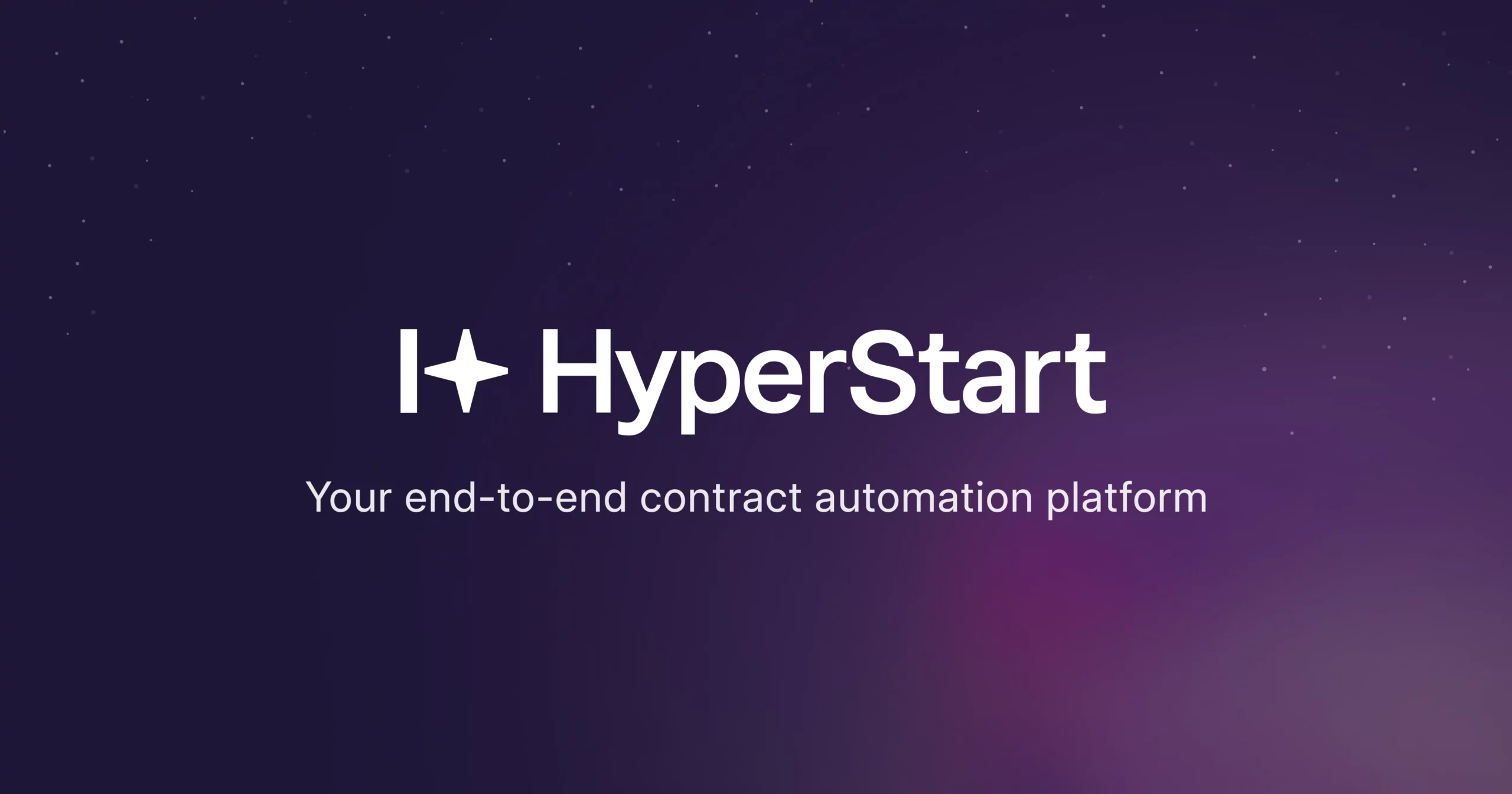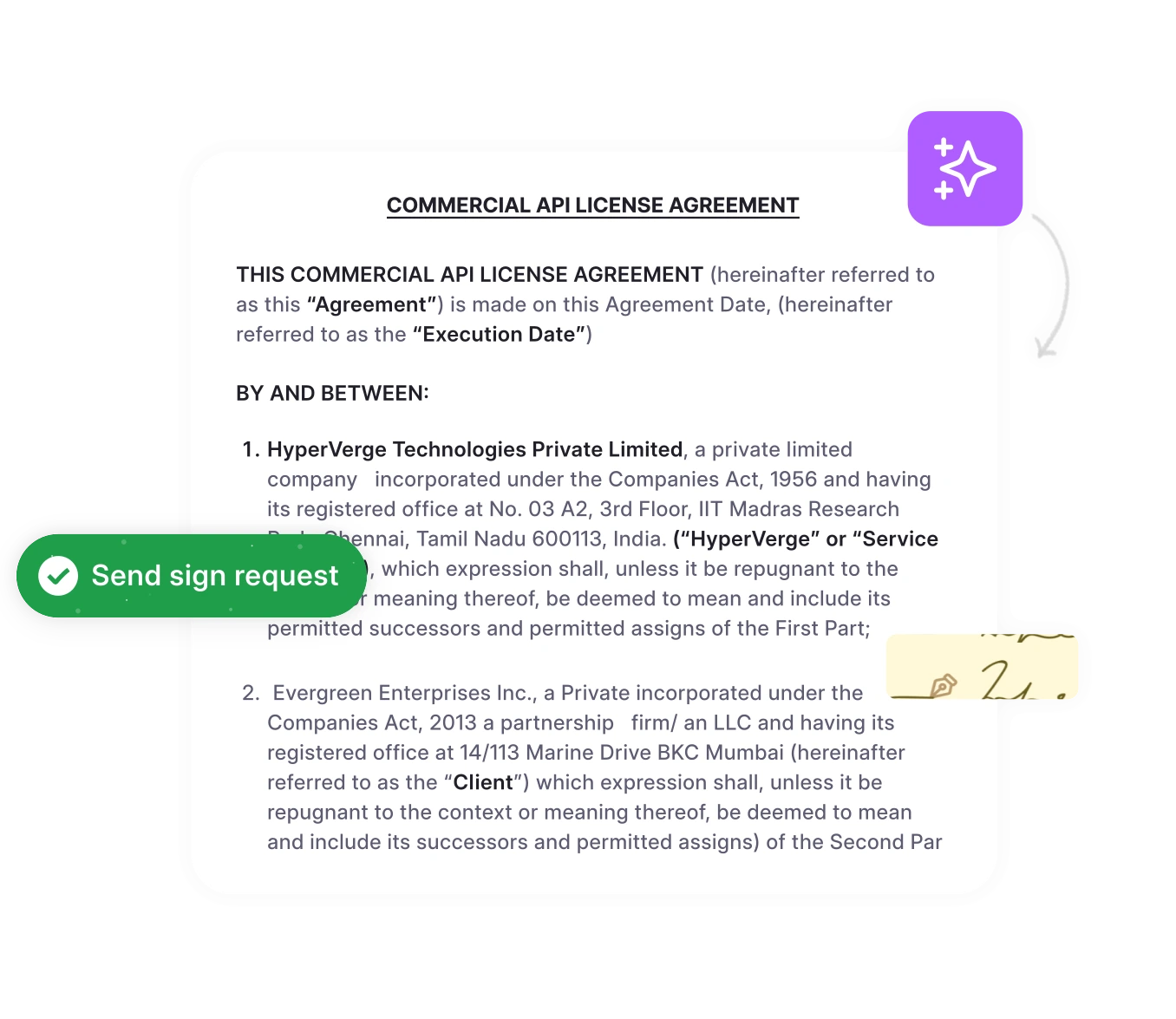Legal teams face mounting pressure to manage increasingly complex service relationships that extend beyond traditional project-based contracts. Continuing service agreements represent a critical contract type that bridges the gap between one-time engagements and ongoing business partnerships.
Such agreements govern extended service relationships where parties commit to sustained performance over specified periods, creating unique legal and operational challenges that require sophisticated contract management approaches or a versatile AI-powered contract management software.
Understanding their structure, applications, and management requirements enables legal professionals to protect their organizations while facilitating successful long-term business relationships.
What is a continuing service agreement?
A continuing service agreement establishes a contractual framework where one party commits to providing specified services to another party over an extended period. Unlike project-based contracts with defined deliverables, these agreements create ongoing obligations that require sustained performance and effective relationship management.
These arrangements enable organizations to secure critical services while providing service providers with predictable revenue streams and fostering deeper client relationships, emphasizing consistent performance over discrete project completion.
Commercial continuing service agreements vs government CSAs
The term encompasses two distinct categories. Commercial continuing service agreements primarily focus on business-to-business relationships for services such as IT support, facilities management, or post-acquisition transitions. Government CSAs operate under federal regulations governing employee training obligations, as outlined in 5 U.S.C. § 4108.
Legal teams primarily encounter commercial agreements, which offer greater contractual flexibility than government counterparts. This distinction is critical when researching precedents.
Common business scenarios and use cases
Continuing service agreements serve multiple strategic purposes across various business contexts. Understanding these applications helps legal teams recognize when this contract structure provides optimal protection and flexibility.
Key business scenarios include:
- Post-acquisition service continuity- Sellers continue providing critical services during transition periods, including payroll administration, customer support, technical maintenance, or specialized operational knowledge transfer.
- Construction and engineering projects- Ongoing maintenance, warranty support, or facility management services where buyers benefit from retaining the original contractor’s institutional knowledge.
- Technology partnerships- Software maintenance, technical support, and system integration services for complex technology ecosystems requiring long-term support commitments. These arrangements often evolve from initial contract automation implementations.
- Professional services relationships- Transition from project-based work to ongoing advisory arrangements where legal, accounting, marketing, and other professional service providers establish sustained expertise access with predictable revenue streams.
- Facilities and operational support- Long-term maintenance agreements for critical infrastructure, security services, or specialized operational functions
- Supply chain partnerships- Extended supplier relationships for critical components or services where continuity provides strategic advantages beyond cost considerations
Modern legal teams increasingly recognize the strategic value of continuing service agreements for complex technology initiatives. Rather than negotiating separate contracts for each implementation phase, organizations establish comprehensive service relationships that adapt to evolving business requirements while maintaining operational continuity.
Prevent missed deadlines and compliance risks
Automatically track all obligations, renewal dates, and regulatory requirements with HyperStart – an AI contract management platform.
Book a DemoEssential components and key clauses for legal teams
Effective continuing service agreements require careful attention to specific contractual elements that address the unique challenges of ongoing service relationships. Legal teams must strike a balance between flexibility and certainty, ensuring that agreements provide clear guidance while accommodating evolving business needs.
1. Service specifications and scope
Service specifications form the foundation of continuing service agreements, requiring detailed descriptions that prevent scope creep while maintaining operational flexibility. Well-crafted service level agreements establish measurable performance criteria that enable the objective evaluation of service quality.
Essential performance measurement approaches:
- Quantitative metrics- System uptime, response times, throughput volumes, error rates
- Qualitative assessments- Customer satisfaction surveys, relationship reviews, strategic alignment
- Balanced scorecards- Combined measurement approaches for comprehensive evaluation
- Performance benchmarking- Comparative assessment across service relationships
2. Compensation and payment terms
Compensation structures must account for extended performance periods and potential variations in service. Legal teams should consider multiple pricing models that align with their organization’s cash flow and risk management objectives.
- Fixed-fee arrangements provide budget predictability but may not accommodate service-level changes. Variable pricing models tie compensation to actual service usage or performance metrics, offering flexibility but requiring robust measurement systems. Cost-plus arrangements provide transparency in service provider expenses while ensuring reasonable profit margins.
- Performance incentives and penalties align the interests of service providers with those of clients. Bonus payments for exceeding SLAs or financial penalties for performance failures create strong motivation for sustained excellence.
Structure payment terms and renewal reminders to align with your organization’s budget cycles.
3. Term, renewal, and termination provisions
The temporal aspects of continuing service agreements need sophisticated planning that strikes a balance between commitment and flexibility. The initial term duration should align with the business planning cycles and provide sufficient time to realize the full value of the relationship.
- Automatic renewal clauses streamline contract administration by eliminating the need for active renegotiation when relationships perform well. Contract renewal management becomes critical for organizations with multiple simultaneous service agreements.
- Termination rights must address both convenience and cause-based termination scenarios. Transition assistance obligations ensure a smooth handover when agreements terminate, including the transfer of documentation, training, and temporary transition support.
Key renewal management strategies:
- Performance review cycles aligned with renewal timelines
- Market analysis for competitive pricing and service standards
- Relationship assessment covering operational and strategic value
- Systematic review processes for modification identification
4. Confidentiality and proprietary information
Extended service relationships create sustained exposure to confidential business information, requiring robust protection mechanisms. Effective contract management systems enable legal teams to track and enforce critical provisions across multiple ongoing relationships.
- Confidentiality scope definitions should encompass all types of information that parties may encounter during extended service relationships. This includes technical specifications, customer data, business strategies, financial information, and operational procedures.
- Data security requirements must address information handling throughout the service relationship lifecycle, including access controls, storage requirements, transmission protocols, and disposal procedures upon termination of agreements. Return or destruction obligations ensure confidential information doesn’t persist beyond the business relationship.
You get an MSA from a big client which will go into some 20-30-40 pages. The usual time for the legal counsel to manually review it and revert would be between 4 and 6 hours. Using Hyperstart, we can get a first-cut review with highlights of around 20 critical items in less than one minute.

Om Prakash Pandey
Legal Counsel Head
Continuing service agreement vs other contract types
Understanding the distinctions between continuing service agreements and other standard business contracts enables legal teams to select optimal structures for specific business relationships. Each contract type serves a different purpose and creates distinct legal obligations that impact ongoing business operations.
1. MSAs vs continuing service agreements
Master Service Agreements (MSAs) establish overarching terms that govern multiple individual service engagements through separate statements of work, providing efficiency for various services over time.
Continuing service agreements create ongoing obligations without requiring separate project documents, working best for sustained services where the scope remains consistent. Vendor contract management often involves coordinating between these contract types to create comprehensive service frameworks.
2. SOWs vs continuing service agreements
Statements of Work define discrete projects with specific deliverables and completion criteria. In contrast, continuing service agreements establish sustained relationships where success depends on ongoing performance rather than the completion of specific deliverables. SOWs provide project certainty with clear endpoints, whereas continuing service agreements are suitable for services where value accumulates over time, and relationship continuity offers strategic advantages.
When to use each contract type
Selecting appropriate contract structures requires careful analysis of business objectives, relationship dynamics, and risk management priorities. Legal teams must consider both immediate needs and long-term strategic implications when advising on contract structure decisions.
| Contract Type | Use cases | Advantages | Duration |
| MSA + SOWs | Multiple projects with the same vendor, changing requirements, and preferred vendor relationships | Flexibility, project-specific terms, scalable relationship | 2-5 years (MSA) |
| Continuing Service Agreement | Sustained service delivery, relationship continuity critical, service interruption costly | Operational stability, reduced admin, predictable costs | 1-3 years |
| Statement of Work | Well-defined projects, clear deliverables, and limited ongoing relationships are needed | Clear scope, defined completion, and budget control | 3-18 months |
| Hybrid Approach | Complex relationships requiring both ongoing services and discrete projects | Comprehensive coverage, optimized structure | Varies |
Decision framework considerations:
- Choose MSA frameworks for consulting, marketing, or technology services where needs evolve rapidly and you require various services from providers over extended periods
- Select continuing service agreements for facilities management, IT support, or critical business process outsourcing where service interruptions significantly impact operations
- Use SOW structures for software development, construction projects, or discrete consulting engagements with well-defined deliverables and limited risk from relationship duration
- Consider hybrid approaches that combine multiple contract types using MSAs for overarching terms, continuing service agreements for core ongoing services, and SOWs for specific project work
Legal considerations and compliance requirements
Continuing service agreements create extended legal exposures that require proactive risk management and contract compliance monitoring throughout the relationship lifecycle. Legal teams must address both standard contractual risks and unique challenges that arise from sustained business relationships.
1. Risk mitigation strategies
Extended commercial service agreements accumulate risks over time, requiring sophisticated mitigation strategies that address both immediate performance concerns and long-term relationship dynamics.
Effective legal contract management enables proactive risk identification and mitigation throughout the lifecycle of continuing service agreements.
Essential risk management controls for service agreements:
The NIST Risk Management Framework (RMF) offers a structured, repeatable, and measurable approach for managing information security and privacy risks across continuing service agreements. It links to a comprehensive suite of NIST standards and guidelines that support risk programs in compliance with the Federal Information Security Modernization Act (FISMA).
The RMF consists of seven essential steps that legal and compliance teams can integrate into service agreement oversight:
- Prepare – Establish risk context and organizational readiness.
- Categorize – Define the system and information impact level based on security and privacy risks.
- Select – Identify appropriate NIST SP 800-53 controls aligned with risk assessments.
- Implement – Deploy selected controls and document implementation details.
- Assess – Evaluate whether controls are adequate and produce intended results.
- Authorize – Enable senior officials to make risk-based operational decisions.
- Monitor – Continuously track control performance and emerging risks over time.
This structured process ensures that extended commercial service agreements remain secure, compliant, and adaptable to evolving regulatory and operational requirements.
Industry-specific compliance requirements
Different industries impose specific regulatory requirements that affect continuing service agreement structure and management. Legal teams must ensure agreements accommodate these requirements while providing necessary compliance monitoring and enforcement mechanisms.
| Industry | Regulations | Requirements | Provisions |
| Financial Services | SOX, Dodd-Frank, Bank Secrecy Act | Third-party risk management, regulatory examination rights | Regulatory reporting, oversight requirements, and examination cooperation |
| Healthcare | HIPAA, HITECH, and FDA regulations | Patient data protection, breach notification | Data protection, breach procedures, audit rights |
| Government Contracting | FAR, DFARS, security requirements | Security clearances, specialized reporting | Clearance requirements, audit rights, and unique termination procedures |
| Data-Intensive Industries | GDPR, CCPA, state privacy laws | Data sovereignty, privacy controls | Regulatory adaptation mechanisms, compliance monitoring |
Regulatory adaptation strategies:
- Financial services continuing service agreements must address strict due diligence requirements, ongoing monitoring obligations, and regulatory reporting responsibilities, including examination rights and compliance documentation.
- Healthcare compliance requires comprehensive data protection requirements, breach notification procedures, and audit rights, ensuring ongoing HIPAA, HITECH compliance throughout extended relationships.
- Government contracting involves security clearance requirements, compliance certifications, and specialized reporting obligations with unique termination procedures and government audit rights.
- Data protection regulations create ongoing obligations that may evolve during extended service relationships, requiring mechanisms for adapting to regulatory changes and ensuring sustained compliance.
Supply and service contractors that employ 50 or more employees and hold a contract above a specific value are required to develop and maintain a written AAP under each of the authorities enforced by OFCCP.
Read →
Pro-tip: Include “regulatory change” provisions that require service providers to adapt their practices when new regulations affect service delivery. This protects both parties from compliance failures due to evolving regulatory landscapes.
Eliminate contract compliance risks
Stay audit-ready with automated obligation tracking, real-time compliance monitoring, and proactive risk alerts that prevent costly oversights.
Book a Demo3. Liability and indemnification clauses
Extended commercial service agreements create accumulated liability exposures that require careful allocation between parties. Effective liability management balances risk protection with relationship viability while addressing the unique challenges of sustained service delivery.
Key liability management components for continuing service agreements:
Liability and indemnification structure:
- Annual liability limits work better than per-incident caps for ongoing services where damages accumulate over extended periods
- Unlimited liability categories should include data breaches, confidentiality violations, and gross negligence
- Include direct service failures, IP infringement, regulatory violations, and third-party claims in the indemnification framework
- Establish mutual indemnification for actions within each party ‘s control, with exclusions for client-directed actions
Insurance and damage limitation:
- Require professional liability, cyber liability, and general commercial coverage with policy limits reflecting potential service interruption exposure
- Exclude consequential damages for routine service issues while maintaining full recovery rights for willful misconduct
- Balance service provider risk management with client protection needs aligned to industry standards and relationship criticality.
This approach ensures commercial service agreements provide comprehensive protection while maintaining relationship viability throughout the extended service term.
However, implementing these liability frameworks across multiple continuing service agreements presents additional complexity that requires systematic portfolio management strategies.
Managing continuing service agreements at scale
Organizations with multiple continuing service agreements face unique challenges in contract administration, performance monitoring, and relationship management. Traditional contract management approaches often prove inadequate for the sustained oversight required by extended service relationships.
1. Contract lifecycle challenges
Extended commercial service agreements create complex management requirements throughout their lifecycle. Legal teams must balance comprehensive initial negotiations that anticipate various scenarios with ongoing performance monitoring systems that track trends and identify emerging issues.
Unlike project-based contracts with discrete milestones, continuing service agreements demand sustained attention and relationship evolution management to adapt to changing business needs.
Multiple concurrent service relationships require standardized processes, centralized oversight, and technology platforms that become essential for managing administration at scale.
Modern contract lifecycle management platforms provide essential infrastructure for managing these complex requirements at scale. Organizations managing hundreds of ongoing service relationships require sophisticated systems that automate routine administration while identifying issues that require legal attention.
2. AI-powered contract management solutions
Traditional contract management approaches struggle with the volume and complexity of continuing service agreements in modern business environments. AI contract management platforms transform how legal teams handle extended service relationships by automating routine tasks while providing intelligent insights for strategic decision-making.
Core AI automation capabilities:
- Automated monitoring and analysis: Machine learning tracks service level compliance across multiple commercial service agreements simultaneously, providing performance trend identification, predictive issue analysis, and proactive alert generation when intervention is needed. AI-powered extraction of key terms, renewal dates, and critical obligations creates centralized dashboards for comprehensive oversight.
- Renewal and risk management: Automated tracking of renewal deadlines, with stakeholder escalation, facilitates effective renewal negotiations and informed decision-making. Advanced risk assessment encompasses service provider performance analysis, financial stability monitoring, and compliance status tracking, utilizing predictive analytics to inform relationship intervention prioritization.
- Strategic portfolio insights: Real-time compliance dashboards across entire service portfolios enable the automated identification of risks and opportunities, performance-based renewal recommendations, and optimized resource allocation based on risk profiles.
Go from reactive to proactive
HyperStart simplifies continuing service agreement management by automating obligations, tracking renewals, and enhancing efficiency across your contract portfolio.
Book a DemoTransform your agreement management with HyperStart
Continuing service agreements represent critical business relationships that require sophisticated legal and operational management throughout their extended lifecycles. From contract negotiation through performance monitoring and renewal, these commercial service agreements demand sustained attention that traditional approaches struggle to provide effectively.
Legal teams managing multiple service agreements benefit significantly from AI-powered contract management platforms that automate routine administration while providing strategic insights for relationship optimization. Modern business relationships, combined with increasing regulatory requirements, make manual contract management both inefficient and risky.
HyperStart’s AI-native contract lifecycle management platform addresses these challenges with intelligent automation that handles administrative burdens while ensuring critical obligations are never overlooked. With a 2-week implementation and proven faster contract processing, legal teams focus on strategic relationship management rather than administrative tasks.
Organizations ready to transform their continuing service agreement management can leverage AI-driven contract intelligence to maximize value from service relationships while minimizing operational risk through comprehensive contract management software solutions.











